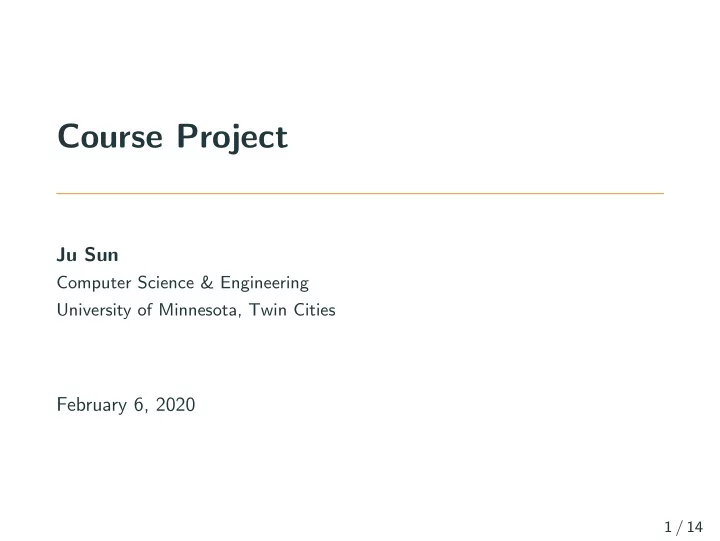

Course Project Ju Sun Computer Science & Engineering University of Minnesota, Twin Cities February 6, 2020 1 / 14
Outline Logistics Project ideas 2 / 14
Timeline & L A T EX template – Proposal ( 5% , 1 page): Feb 16th – Progress presentation ( 5% , 2-3 mins): Mar 26th – Progress report ( 5% , 2 pages): Mar 28th – Final report ( 25% , 6 – 8 pages): May 12th – Poster presentation? – Publisable results = ⇒ A! Template for all writeups: NeurIPS 2019 style https://neurips.cc/Conferences/2019/PaperInformation/ StyleFiles 3 / 14
Groups – Each group: 2 or 3 students; 1 permitted but discouraged – All submissions as a group (in Canvas as group assignment); the group gets the same score 4 / 14
Proposal – What problem? – Why interesting? – Previous work – Your goal – Plan and milestones 5 / 14
Outline Logistics Project ideas 6 / 14
Overview Roughly by ascending level of difficulty – Literature survey/review – Novel applications – Novel methods – Novel theories Excerpt from a research project is fine, but you should describe your own contributions 7 / 14
Literature survey/review A coherent account of recent papers in a focused topic – Description and comparison of main ideas, or – Implementation and comparison of performance, or – Both of the above should complement the topics we cover in the course 8 / 14
Random topics – DL for noneuclidean data (e.g., – DL for games graph NN, manifold NN) – RL for robotics – transformer models for sequential – adversarial attacks; robustness of data DL – generative models (e.g., GAN, – privacy, fairness in DL VAE) – visualization for DNN – 2nd order methods for deep – network quantization and learning compression – differential programming – hardware/software platforms for – universal approximation theorems DL – DL for 3D reconstruction – automated ML; architecture – DL for video understanding and search analysis – optimization/generalization theory – DL for solving PDEs of DL 9 / 14
Novel applications Apply DL to new application problems – A good place to start: Kaggle https://www.kaggle.com/ – Think about data availability Google dataset search https://datasetsearch.research.google.com/ – Think about GPUs 10 / 14
Where to find inspirations – arXiv machine learning https://arxiv.org/list/cs.LG/recent – Recent conference papers ML: NeurIPS, ICML, ICLR, etc CV: ICCV, ECCV, CVPR, etc NLP: ACL, EMNLP, etc Robotics: ICRA, etc Graphics: SIGGRAPH, etc – Talk to researchers! 11 / 14
Novel methods Create new NN models or training algorithms to improve the state-of-the-art Where to start: – Kaggle (again)! – arXiv machine learning and recent conference papers – ICLR reproducibility challenge: https: //reproducibility-challenge.github.io/iclr_2019/ 12 / 14
Novel methods Equally interesting to fool/fail the state-of-the-art, i.e., exploring robustness of DL Credit: ImageNet-C 13 / 14
Novel theories Nothing is more practical than a good theory. – V. Vapnik – universal approximation theorems – nonconvex optimization – generalization Where to start: – Analyses of Deep Learning (Stanford, fall 2019) https://stats385.github.io/ – Theories of Deep Learning (Stanford, fall 2017) https://stats385.github.io/stats385_2017.github.io/ – Toward theoretical understanding of deep learning (ICML 2018 Tutorial) https: //unsupervised.cs.princeton.edu/deeplearningtutorial.html 14 / 14
Questions? 14 / 14
Recommend
More recommend